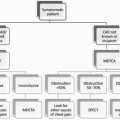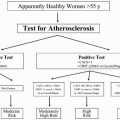LDL-C levels at goal, it is not entirely clear whether the HDL-C increases or TG decreases from statin therapy contribute substantial additional benefit beyond that expected from LDL-C lowering.
TABLE 23.1 OVERVIEW OF LIPID TREATMENT GOALS AND STRATEGIES | ||||||||||||||||||||||||||||||||||||||||||||||||||||||
|---|---|---|---|---|---|---|---|---|---|---|---|---|---|---|---|---|---|---|---|---|---|---|---|---|---|---|---|---|---|---|---|---|---|---|---|---|---|---|---|---|---|---|---|---|---|---|---|---|---|---|---|---|---|---|
| ||||||||||||||||||||||||||||||||||||||||||||||||||||||
amiodarone, calcium channel blockers diltiazem and verapamil (alternatives—amlodipine, nifedipine), and some antidepressants (alternatives—paroxetine, venlafaxine) have also been reported. Alternatives include rosuvastatin, which is minimally metabolized; pravastatin, which has no cytochrome P450 metabolism; and fluvastatin, which is metabolized by the 2C9 pathway. In four statins, glucuronidation has a major role in their metabolism, increasing the potential for their interaction with gemfibrozil (Table 23.2). Cyclosporine raises blood levels of virtually all statins by both cytochrome P450 and other
pathways, and low doses of statins should be titrated carefully if needed.
 FIGURE 23.1 Overview of mechanisms of drug action. Statins inhibit the rate-limiting step in cholesterol synthesis, HMG-CoA reductase. Reduction in intrahepatic FC levels releases SREBP, which binds to the SRE in the promotor of the LDLR gene, increasing the number of LDLRs on the cell membrane, thereby increasing removal of LDL-C from plasma. BAS and EZE also lower plasma LDL-C by the same mechanism. BAS bind bile acids in the intestine, preventing uptake by the IBAT, interrupting the entero-hepatic circulation of biliary FC. EZE and other cholesterol absorption inhibitors act on the NPC1L1 transporter to prevent absorption of dietary and biliary cholesterol, interrupting the entero-hepatic circulation of biliary FC as well as CM assembly. These drugs also block uptake of plant sterols. Dietary sterol/stanols competitively inhibit the uptake of cholesterol. The efficacy of all three intestinally active agents is limited since SREBP also upregulates the gene for HMG-CoA reductase, resulting in a compensatory increase in cholesterol synthesis. The mechanisms of action for niacin have not been clearly elucidated. Niacin partially inhibits release of FFA from adipose and also increases LPL activity, enhancing removal of CM TG from plasma. Niacin decreases apoB synthesis, which lowers VLDL-C and IDL-C and plasma TG levels. Niacin increases HDL-C levels through decreased hepatic uptake, likely through the HUR and catabolism and also by lowering TG levels. Fibrates lower TG levels by decreasing VLDL secretion and increasing catabolism of TG-rich particles via several mechanisms. Fibrates reduce apoC-III production, which upregulates lipoprotein lipase-mediated lipolysis, increase cellular FFA uptake, as well as increase FFA catabolism. Fibrates increase HDL-C via the LXR/RXR heterodimer to upregulate the ABCA1 gene, inducing apoA-I and apoA-II synthesis. O-3 reduce the rate of VLDL synthesis through a number of putative mechanisms inhibiting release of FFA from adipose, inhibiting FFA synthesis, and increasing apoB degradation. ABC, ATP-binding cassette; ACAT, acyl cholesterol acyl transferase; apo B, apolipoprotein B; apo C, apolipoprotein C; B-48 or B-100, apolipoprotein B-48 or B-100; BAS, bile acid-sequestering agents; CE, cholesteryl esters; CETP, cholesterol ester transfer protein; CM, chylomicron; CMR, CM remnant; E, apolipoprotein E; EL, endothelial lipase; EZE, ezetimibe; FC, free cholesterol; FFA, free fatty acids; HDL-C, high-density lipoprotein cholesterol; HMG-CoA, 3-hydroxy-3-methylglutaryl coenzyme A; HL, hepatic lipase; HUR, holo-uptake receptor; IBAT, intestinal bile acid transporter; IDL-C, intermediate density lipoprotein cholesterol; LCAT, lecithin cholesterol acyl transferase; LDLR, low-density lipoprotein-receptor; LXR/RXR, liver X receptor/retinoid X receptor; LPL, lipoprotein lipase; LRP, LDL receptor-related protein 1; MTP, microsomal triglyceride transfer protein; NPC1L1, Niemann-Pick C1-Like 1; O-3, Omega-3 fatty acids; PLTP, phospholipid transport protein; SR-BI, scavenger receptor class BI; SRE, sterol response element; SREBP, sterol regulatory element binding protein; TG, triglycerides; VLDL-C, very low density lipoprotein cholesterol. (see color insert.) |
TABLE 23.2 SUMMARY OF COMPARATIVE PHARMACOKINETICS OF STATINS IN HEALTHY VOLUNTEERS | |||||||||||||||||||||||||||||||||||||||||||||||||||||||||||||||||||||||||||||||||||||||||||
|---|---|---|---|---|---|---|---|---|---|---|---|---|---|---|---|---|---|---|---|---|---|---|---|---|---|---|---|---|---|---|---|---|---|---|---|---|---|---|---|---|---|---|---|---|---|---|---|---|---|---|---|---|---|---|---|---|---|---|---|---|---|---|---|---|---|---|---|---|---|---|---|---|---|---|---|---|---|---|---|---|---|---|---|---|---|---|---|---|---|---|---|
|
TABLE 23.3 SELECTED CLINICALLY RELEVANT STATIN DRUG INTERACTIONS
Stay updated, free articles. Join our Telegram channel
Full access? Get Clinical Tree
 Get Clinical Tree app for offline access
Get Clinical Tree app for offline access

|
|---|




